Taxation Law: A Comprehensive Analysis of Income and Fringe Benefits
VerifiedAdded on 2023/04/24
|11
|2231
|395
Case Study
AI Summary
This case study examines taxation law principles related to partnership income and fringe benefits. It analyzes a scenario involving Olivia and Daniel's partnership, focusing on the taxability of their business income and the deductibility of various expenses. The study computes the partnership's net income, considering factors like business sales, debtors, cash payments, and eligible deductions such as electricity bills, council rates, and repair expenses. It also addresses the tax implications of drawings made by the partners. Furthermore, the case study delves into fringe benefits tax (FBT) concerning an employee, John, focusing on the employer's obligations regarding school fees and housing benefits. The analysis calculates the taxable value of the housing benefit, considering market rent and employee contributions. The study concludes that the employer is liable for FBT on the provided benefits, with the value of these benefits eligible for tax rebates. Desklib offers a range of study tools and resources, including similar solved assignments, to aid students in understanding complex legal and financial concepts.
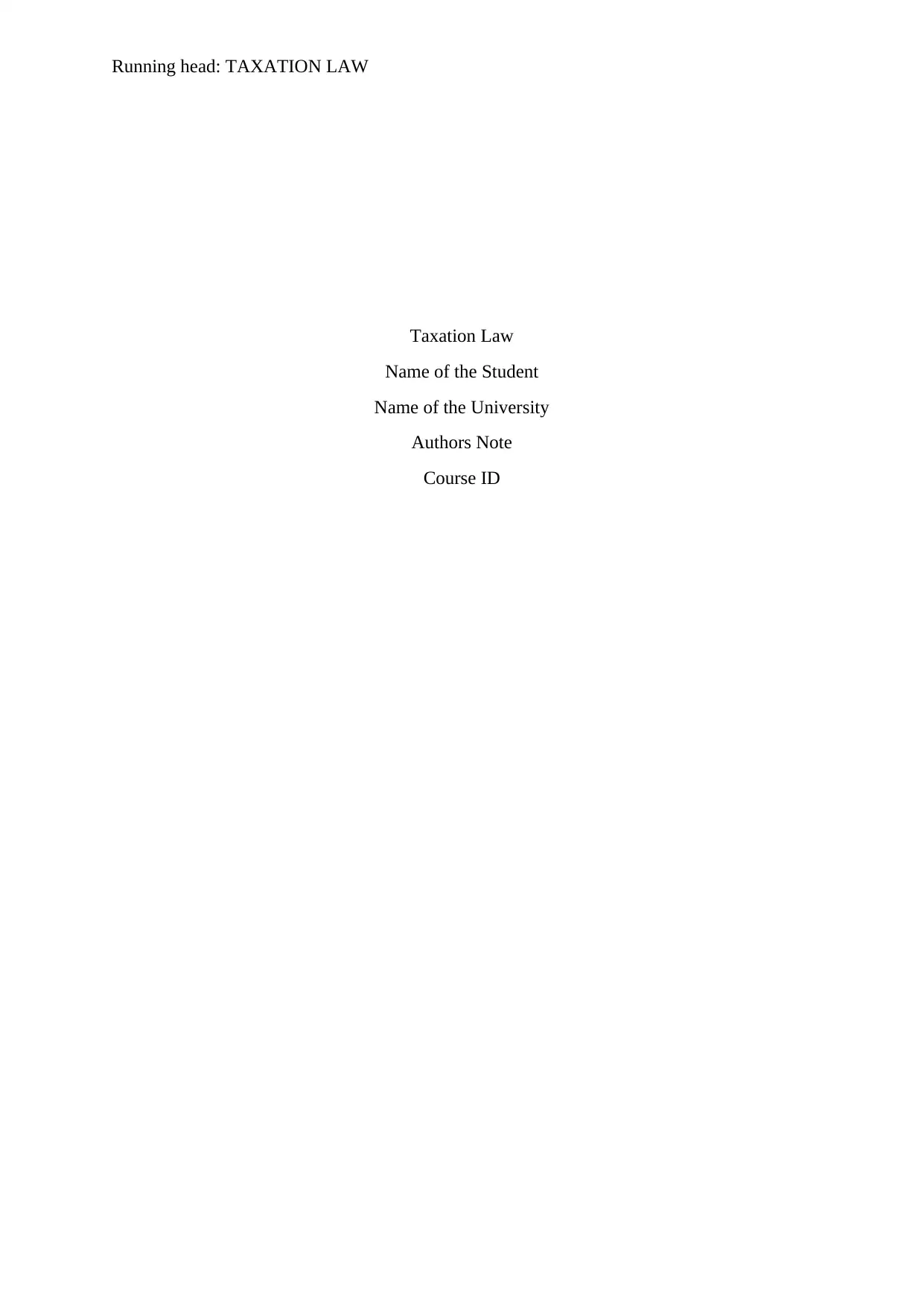
Running head: TAXATION LAW
Taxation Law
Name of the Student
Name of the University
Authors Note
Course ID
Taxation Law
Name of the Student
Name of the University
Authors Note
Course ID
Paraphrase This Document
Need a fresh take? Get an instant paraphrase of this document with our AI Paraphraser
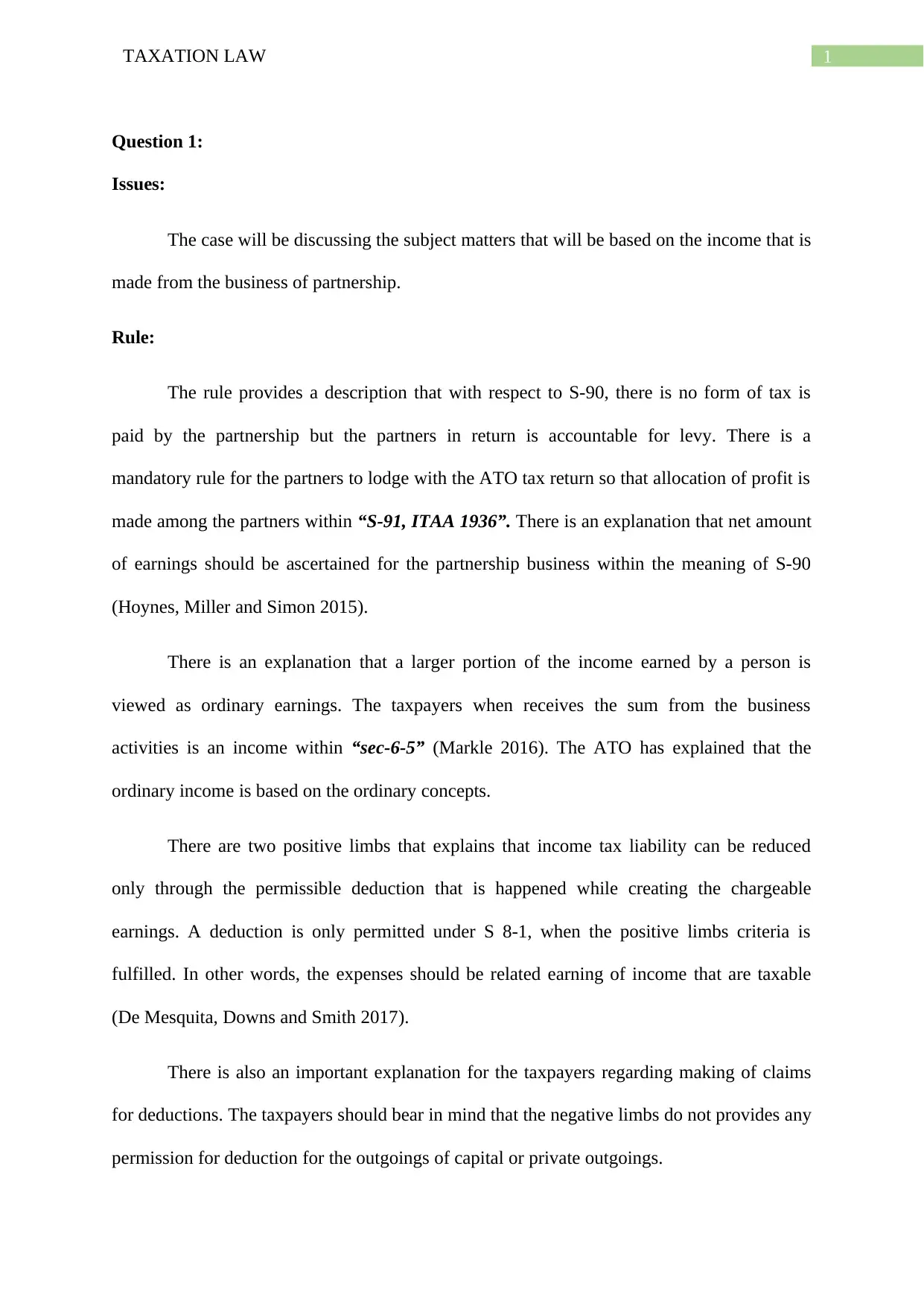
1TAXATION LAW
Question 1:
Issues:
The case will be discussing the subject matters that will be based on the income that is
made from the business of partnership.
Rule:
The rule provides a description that with respect to S-90, there is no form of tax is
paid by the partnership but the partners in return is accountable for levy. There is a
mandatory rule for the partners to lodge with the ATO tax return so that allocation of profit is
made among the partners within “S-91, ITAA 1936”. There is an explanation that net amount
of earnings should be ascertained for the partnership business within the meaning of S-90
(Hoynes, Miller and Simon 2015).
There is an explanation that a larger portion of the income earned by a person is
viewed as ordinary earnings. The taxpayers when receives the sum from the business
activities is an income within “sec-6-5” (Markle 2016). The ATO has explained that the
ordinary income is based on the ordinary concepts.
There are two positive limbs that explains that income tax liability can be reduced
only through the permissible deduction that is happened while creating the chargeable
earnings. A deduction is only permitted under S 8-1, when the positive limbs criteria is
fulfilled. In other words, the expenses should be related earning of income that are taxable
(De Mesquita, Downs and Smith 2017).
There is also an important explanation for the taxpayers regarding making of claims
for deductions. The taxpayers should bear in mind that the negative limbs do not provides any
permission for deduction for the outgoings of capital or private outgoings.
Question 1:
Issues:
The case will be discussing the subject matters that will be based on the income that is
made from the business of partnership.
Rule:
The rule provides a description that with respect to S-90, there is no form of tax is
paid by the partnership but the partners in return is accountable for levy. There is a
mandatory rule for the partners to lodge with the ATO tax return so that allocation of profit is
made among the partners within “S-91, ITAA 1936”. There is an explanation that net amount
of earnings should be ascertained for the partnership business within the meaning of S-90
(Hoynes, Miller and Simon 2015).
There is an explanation that a larger portion of the income earned by a person is
viewed as ordinary earnings. The taxpayers when receives the sum from the business
activities is an income within “sec-6-5” (Markle 2016). The ATO has explained that the
ordinary income is based on the ordinary concepts.
There are two positive limbs that explains that income tax liability can be reduced
only through the permissible deduction that is happened while creating the chargeable
earnings. A deduction is only permitted under S 8-1, when the positive limbs criteria is
fulfilled. In other words, the expenses should be related earning of income that are taxable
(De Mesquita, Downs and Smith 2017).
There is also an important explanation for the taxpayers regarding making of claims
for deductions. The taxpayers should bear in mind that the negative limbs do not provides any
permission for deduction for the outgoings of capital or private outgoings.
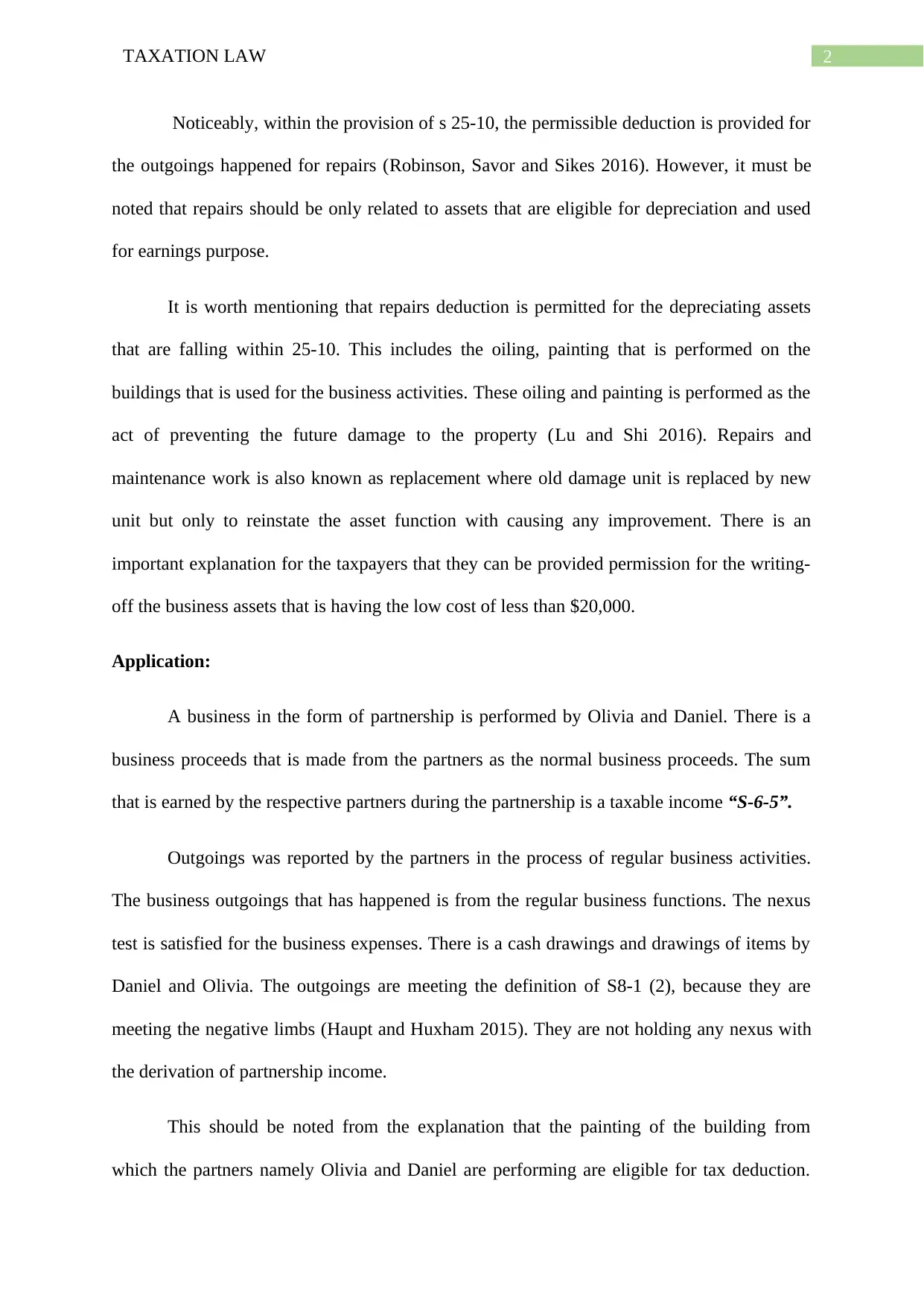
2TAXATION LAW
Noticeably, within the provision of s 25-10, the permissible deduction is provided for
the outgoings happened for repairs (Robinson, Savor and Sikes 2016). However, it must be
noted that repairs should be only related to assets that are eligible for depreciation and used
for earnings purpose.
It is worth mentioning that repairs deduction is permitted for the depreciating assets
that are falling within 25-10. This includes the oiling, painting that is performed on the
buildings that is used for the business activities. These oiling and painting is performed as the
act of preventing the future damage to the property (Lu and Shi 2016). Repairs and
maintenance work is also known as replacement where old damage unit is replaced by new
unit but only to reinstate the asset function with causing any improvement. There is an
important explanation for the taxpayers that they can be provided permission for the writing-
off the business assets that is having the low cost of less than $20,000.
Application:
A business in the form of partnership is performed by Olivia and Daniel. There is a
business proceeds that is made from the partners as the normal business proceeds. The sum
that is earned by the respective partners during the partnership is a taxable income “S-6-5”.
Outgoings was reported by the partners in the process of regular business activities.
The business outgoings that has happened is from the regular business functions. The nexus
test is satisfied for the business expenses. There is a cash drawings and drawings of items by
Daniel and Olivia. The outgoings are meeting the definition of S8-1 (2), because they are
meeting the negative limbs (Haupt and Huxham 2015). They are not holding any nexus with
the derivation of partnership income.
This should be noted from the explanation that the painting of the building from
which the partners namely Olivia and Daniel are performing are eligible for tax deduction.
Noticeably, within the provision of s 25-10, the permissible deduction is provided for
the outgoings happened for repairs (Robinson, Savor and Sikes 2016). However, it must be
noted that repairs should be only related to assets that are eligible for depreciation and used
for earnings purpose.
It is worth mentioning that repairs deduction is permitted for the depreciating assets
that are falling within 25-10. This includes the oiling, painting that is performed on the
buildings that is used for the business activities. These oiling and painting is performed as the
act of preventing the future damage to the property (Lu and Shi 2016). Repairs and
maintenance work is also known as replacement where old damage unit is replaced by new
unit but only to reinstate the asset function with causing any improvement. There is an
important explanation for the taxpayers that they can be provided permission for the writing-
off the business assets that is having the low cost of less than $20,000.
Application:
A business in the form of partnership is performed by Olivia and Daniel. There is a
business proceeds that is made from the partners as the normal business proceeds. The sum
that is earned by the respective partners during the partnership is a taxable income “S-6-5”.
Outgoings was reported by the partners in the process of regular business activities.
The business outgoings that has happened is from the regular business functions. The nexus
test is satisfied for the business expenses. There is a cash drawings and drawings of items by
Daniel and Olivia. The outgoings are meeting the definition of S8-1 (2), because they are
meeting the negative limbs (Haupt and Huxham 2015). They are not holding any nexus with
the derivation of partnership income.
This should be noted from the explanation that the painting of the building from
which the partners namely Olivia and Daniel are performing are eligible for tax deduction.
⊘ This is a preview!⊘
Do you want full access?
Subscribe today to unlock all pages.

Trusted by 1+ million students worldwide
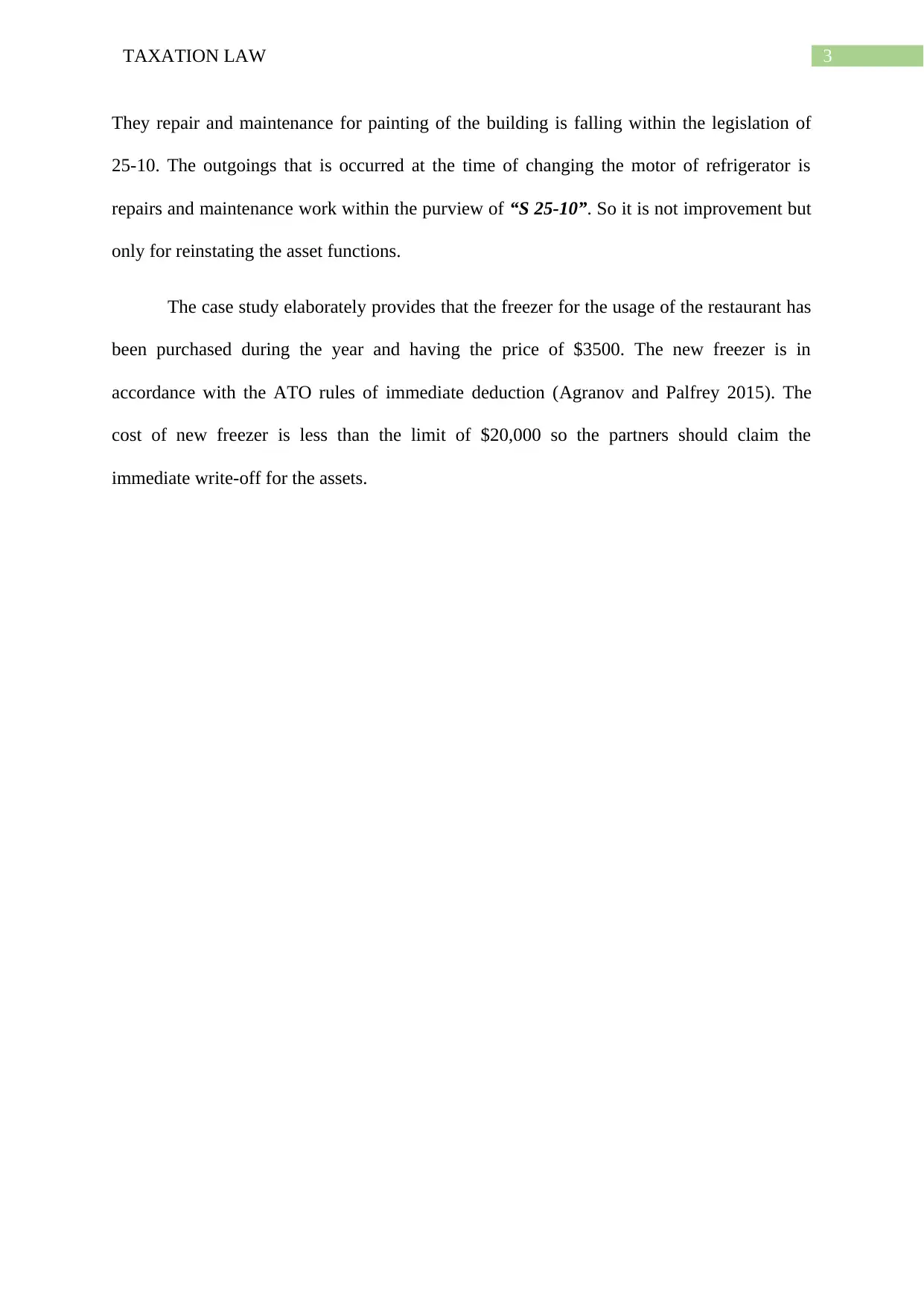
3TAXATION LAW
They repair and maintenance for painting of the building is falling within the legislation of
25-10. The outgoings that is occurred at the time of changing the motor of refrigerator is
repairs and maintenance work within the purview of “S 25-10”. So it is not improvement but
only for reinstating the asset functions.
The case study elaborately provides that the freezer for the usage of the restaurant has
been purchased during the year and having the price of $3500. The new freezer is in
accordance with the ATO rules of immediate deduction (Agranov and Palfrey 2015). The
cost of new freezer is less than the limit of $20,000 so the partners should claim the
immediate write-off for the assets.
They repair and maintenance for painting of the building is falling within the legislation of
25-10. The outgoings that is occurred at the time of changing the motor of refrigerator is
repairs and maintenance work within the purview of “S 25-10”. So it is not improvement but
only for reinstating the asset functions.
The case study elaborately provides that the freezer for the usage of the restaurant has
been purchased during the year and having the price of $3500. The new freezer is in
accordance with the ATO rules of immediate deduction (Agranov and Palfrey 2015). The
cost of new freezer is less than the limit of $20,000 so the partners should claim the
immediate write-off for the assets.
Paraphrase This Document
Need a fresh take? Get an instant paraphrase of this document with our AI Paraphraser
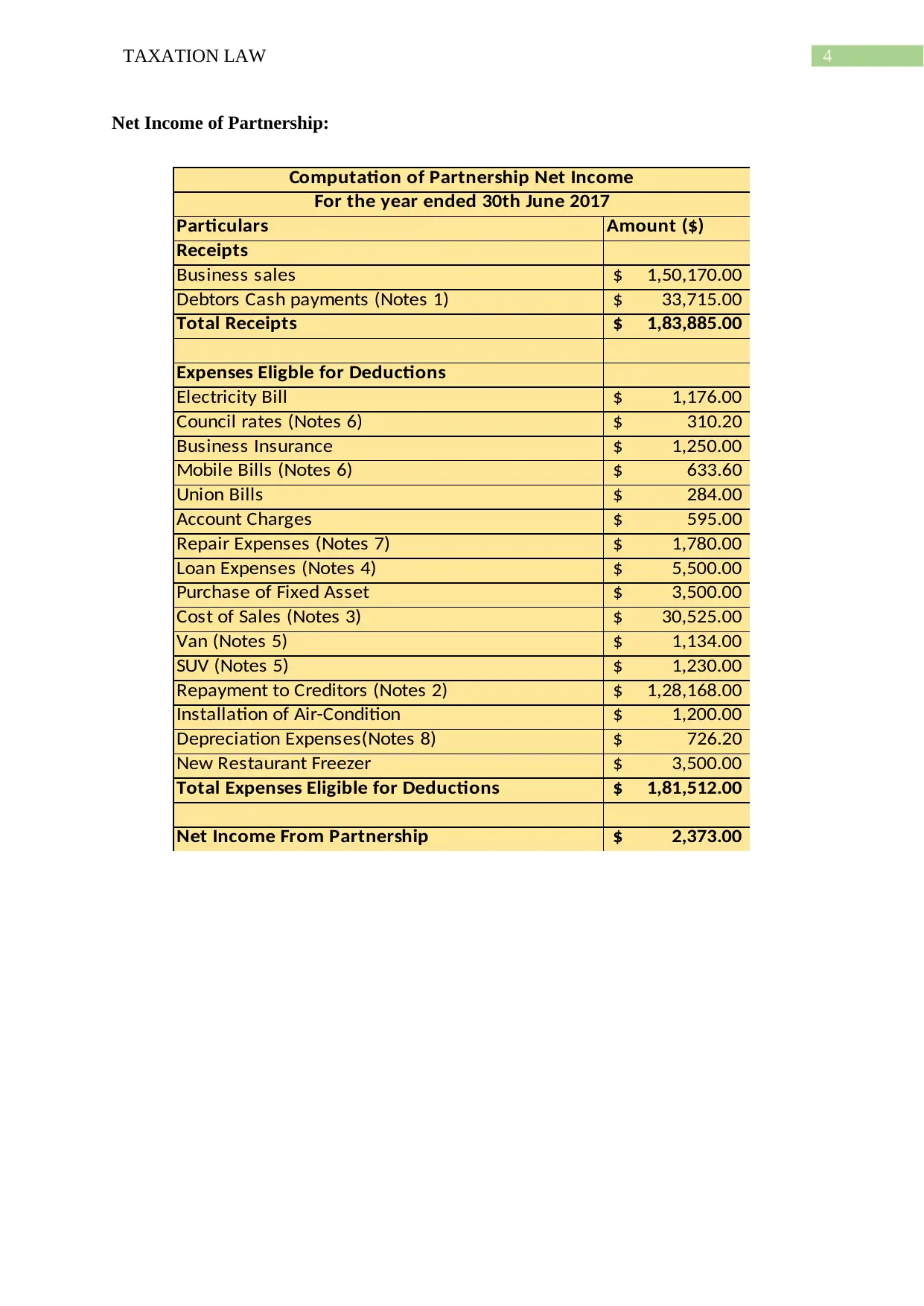
4TAXATION LAW
Net Income of Partnership:
Particulars Amount ($)
Receipts
Business sales 1,50,170.00$
Debtors Cash payments (Notes 1) 33,715.00$
Total Receipts 1,83,885.00$
Expenses Eligble for Deductions
Electricity Bill 1,176.00$
Council rates (Notes 6) 310.20$
Business Insurance 1,250.00$
Mobile Bills (Notes 6) 633.60$
Union Bills 284.00$
Account Charges 595.00$
Repair Expenses (Notes 7) 1,780.00$
Loan Expenses (Notes 4) 5,500.00$
Purchase of Fixed Asset 3,500.00$
Cost of Sales (Notes 3) 30,525.00$
Van (Notes 5) 1,134.00$
SUV (Notes 5) 1,230.00$
Repayment to Creditors (Notes 2) 1,28,168.00$
Installation of Air-Condition 1,200.00$
Depreciation Expenses(Notes 8) 726.20$
New Restaurant Freezer 3,500.00$
Total Expenses Eligible for Deductions 1,81,512.00$
Net Income From Partnership 2,373.00$
Computation of Partnership Net Income
For the year ended 30th June 2017
Net Income of Partnership:
Particulars Amount ($)
Receipts
Business sales 1,50,170.00$
Debtors Cash payments (Notes 1) 33,715.00$
Total Receipts 1,83,885.00$
Expenses Eligble for Deductions
Electricity Bill 1,176.00$
Council rates (Notes 6) 310.20$
Business Insurance 1,250.00$
Mobile Bills (Notes 6) 633.60$
Union Bills 284.00$
Account Charges 595.00$
Repair Expenses (Notes 7) 1,780.00$
Loan Expenses (Notes 4) 5,500.00$
Purchase of Fixed Asset 3,500.00$
Cost of Sales (Notes 3) 30,525.00$
Van (Notes 5) 1,134.00$
SUV (Notes 5) 1,230.00$
Repayment to Creditors (Notes 2) 1,28,168.00$
Installation of Air-Condition 1,200.00$
Depreciation Expenses(Notes 8) 726.20$
New Restaurant Freezer 3,500.00$
Total Expenses Eligible for Deductions 1,81,512.00$
Net Income From Partnership 2,373.00$
Computation of Partnership Net Income
For the year ended 30th June 2017
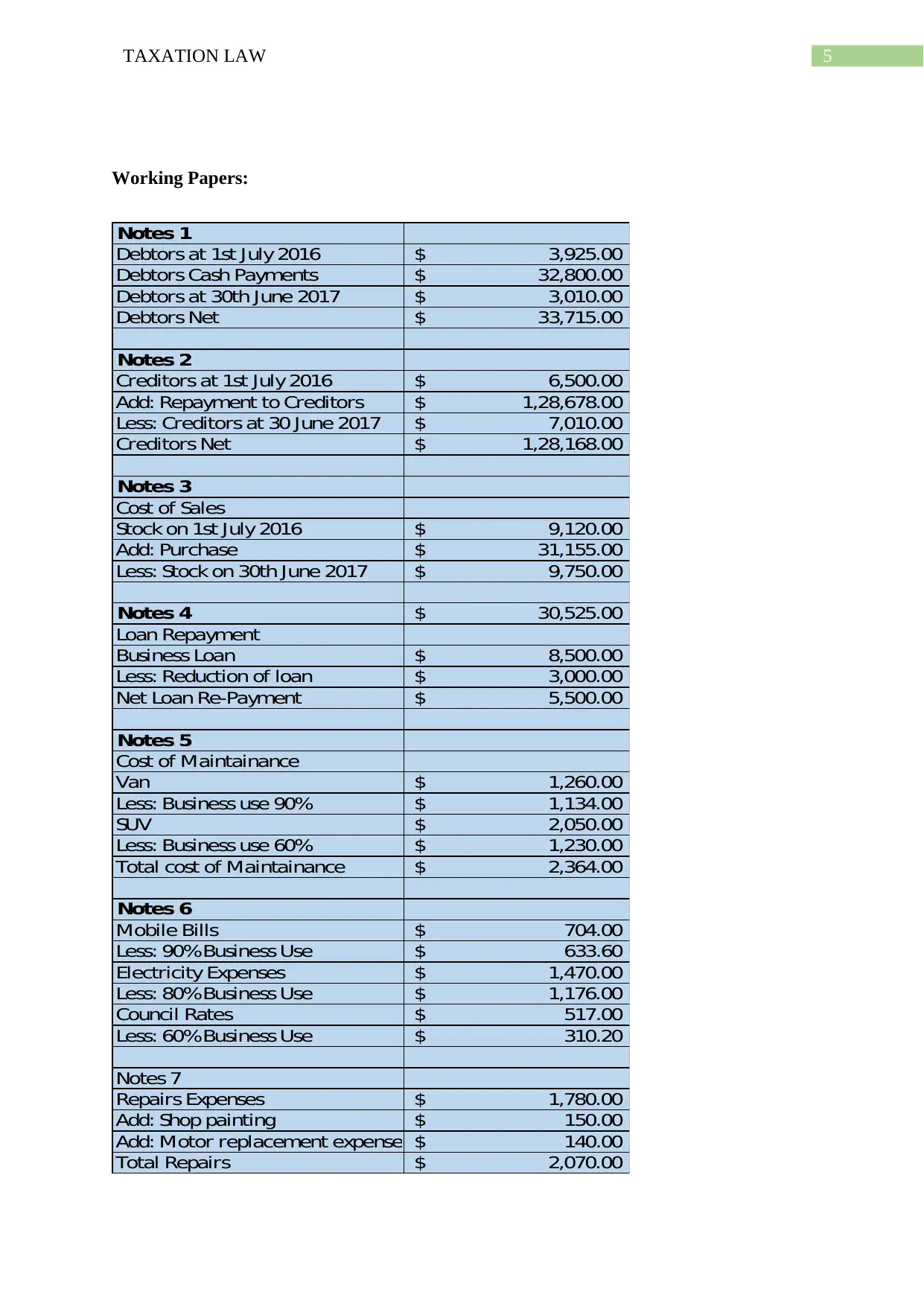
5TAXATION LAW
Working Papers:
Notes 1
Debtors at 1st July 2016 3,925.00$
Debtors Cash Payments 32,800.00$
Debtors at 30th June 2017 3,010.00$
Debtors Net 33,715.00$
Notes 2
Creditors at 1st July 2016 6,500.00$
Add: Repayment to Creditors 1,28,678.00$
Less: Creditors at 30 June 2017 7,010.00$
Creditors Net 1,28,168.00$
Notes 3
Cost of Sales
Stock on 1st July 2016 9,120.00$
Add: Purchase 31,155.00$
Less: Stock on 30th June 2017 9,750.00$
Notes 4 30,525.00$
Loan Repayment
Business Loan 8,500.00$
Less: Reduction of loan 3,000.00$
Net Loan Re-Payment 5,500.00$
Notes 5
Cost of Maintainance
Van 1,260.00$
Less: Business use 90% 1,134.00$
SUV 2,050.00$
Less: Business use 60% 1,230.00$
Total cost of Maintainance 2,364.00$
Notes 6
Mobile Bills 704.00$
Less: 90%Business Use 633.60$
Electricity Expenses 1,470.00$
Less: 80%Business Use 1,176.00$
Council Rates 517.00$
Less: 60%Business Use 310.20$
Notes 7
Repairs Expenses 1,780.00$
Add: Shop painting 150.00$
Add: Motor replacement expenses 140.00$
Total Repairs 2,070.00$
Working Papers:
Notes 1
Debtors at 1st July 2016 3,925.00$
Debtors Cash Payments 32,800.00$
Debtors at 30th June 2017 3,010.00$
Debtors Net 33,715.00$
Notes 2
Creditors at 1st July 2016 6,500.00$
Add: Repayment to Creditors 1,28,678.00$
Less: Creditors at 30 June 2017 7,010.00$
Creditors Net 1,28,168.00$
Notes 3
Cost of Sales
Stock on 1st July 2016 9,120.00$
Add: Purchase 31,155.00$
Less: Stock on 30th June 2017 9,750.00$
Notes 4 30,525.00$
Loan Repayment
Business Loan 8,500.00$
Less: Reduction of loan 3,000.00$
Net Loan Re-Payment 5,500.00$
Notes 5
Cost of Maintainance
Van 1,260.00$
Less: Business use 90% 1,134.00$
SUV 2,050.00$
Less: Business use 60% 1,230.00$
Total cost of Maintainance 2,364.00$
Notes 6
Mobile Bills 704.00$
Less: 90%Business Use 633.60$
Electricity Expenses 1,470.00$
Less: 80%Business Use 1,176.00$
Council Rates 517.00$
Less: 60%Business Use 310.20$
Notes 7
Repairs Expenses 1,780.00$
Add: Shop painting 150.00$
Add: Motor replacement expenses 140.00$
Total Repairs 2,070.00$
⊘ This is a preview!⊘
Do you want full access?
Subscribe today to unlock all pages.

Trusted by 1+ million students worldwide
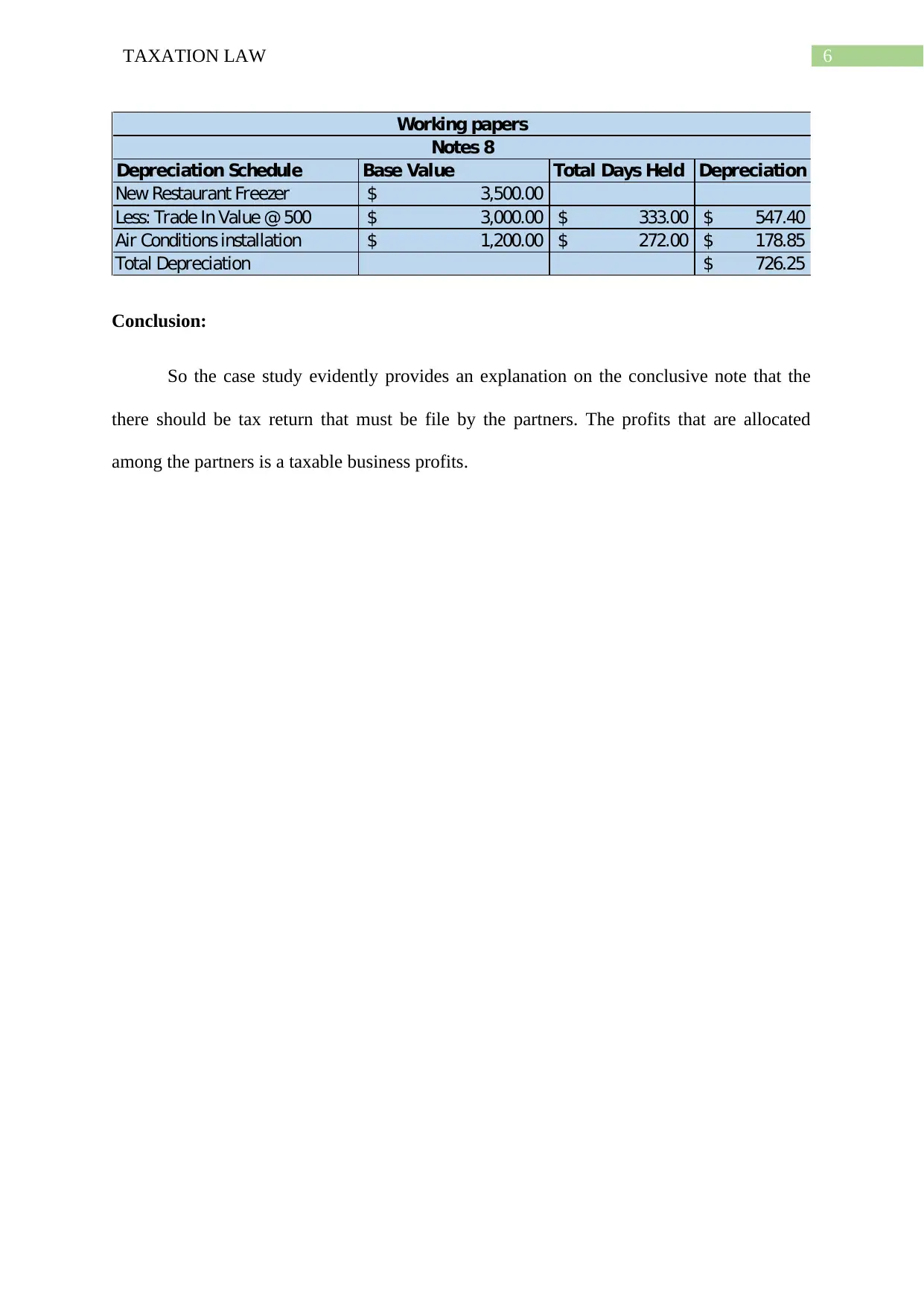
6TAXATION LAW
Depreciation Schedule Base Value Total Days Held Depreciation
New Restaurant Freezer 3,500.00$
Less: Trade In Value @ 500 3,000.00$ 333.00$ 547.40$
Air Conditions installation 1,200.00$ 272.00$ 178.85$
Total Depreciation 726.25$
Working papers
Notes 8
Conclusion:
So the case study evidently provides an explanation on the conclusive note that the
there should be tax return that must be file by the partners. The profits that are allocated
among the partners is a taxable business profits.
Depreciation Schedule Base Value Total Days Held Depreciation
New Restaurant Freezer 3,500.00$
Less: Trade In Value @ 500 3,000.00$ 333.00$ 547.40$
Air Conditions installation 1,200.00$ 272.00$ 178.85$
Total Depreciation 726.25$
Working papers
Notes 8
Conclusion:
So the case study evidently provides an explanation on the conclusive note that the
there should be tax return that must be file by the partners. The profits that are allocated
among the partners is a taxable business profits.
Paraphrase This Document
Need a fresh take? Get an instant paraphrase of this document with our AI Paraphraser
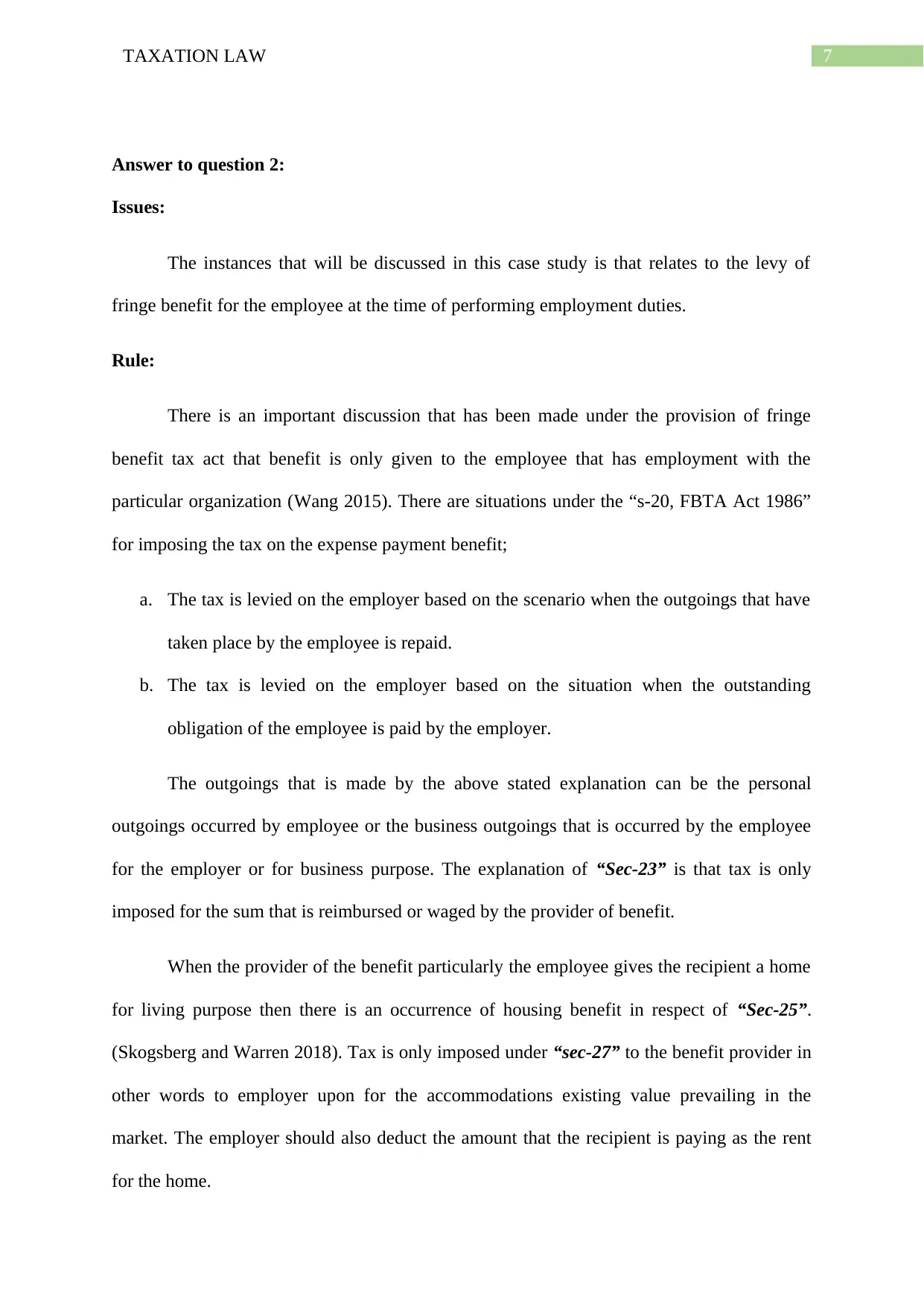
7TAXATION LAW
Answer to question 2:
Issues:
The instances that will be discussed in this case study is that relates to the levy of
fringe benefit for the employee at the time of performing employment duties.
Rule:
There is an important discussion that has been made under the provision of fringe
benefit tax act that benefit is only given to the employee that has employment with the
particular organization (Wang 2015). There are situations under the “s-20, FBTA Act 1986”
for imposing the tax on the expense payment benefit;
a. The tax is levied on the employer based on the scenario when the outgoings that have
taken place by the employee is repaid.
b. The tax is levied on the employer based on the situation when the outstanding
obligation of the employee is paid by the employer.
The outgoings that is made by the above stated explanation can be the personal
outgoings occurred by employee or the business outgoings that is occurred by the employee
for the employer or for business purpose. The explanation of “Sec-23” is that tax is only
imposed for the sum that is reimbursed or waged by the provider of benefit.
When the provider of the benefit particularly the employee gives the recipient a home
for living purpose then there is an occurrence of housing benefit in respect of “Sec-25”.
(Skogsberg and Warren 2018). Tax is only imposed under “sec-27” to the benefit provider in
other words to employer upon for the accommodations existing value prevailing in the
market. The employer should also deduct the amount that the recipient is paying as the rent
for the home.
Answer to question 2:
Issues:
The instances that will be discussed in this case study is that relates to the levy of
fringe benefit for the employee at the time of performing employment duties.
Rule:
There is an important discussion that has been made under the provision of fringe
benefit tax act that benefit is only given to the employee that has employment with the
particular organization (Wang 2015). There are situations under the “s-20, FBTA Act 1986”
for imposing the tax on the expense payment benefit;
a. The tax is levied on the employer based on the scenario when the outgoings that have
taken place by the employee is repaid.
b. The tax is levied on the employer based on the situation when the outstanding
obligation of the employee is paid by the employer.
The outgoings that is made by the above stated explanation can be the personal
outgoings occurred by employee or the business outgoings that is occurred by the employee
for the employer or for business purpose. The explanation of “Sec-23” is that tax is only
imposed for the sum that is reimbursed or waged by the provider of benefit.
When the provider of the benefit particularly the employee gives the recipient a home
for living purpose then there is an occurrence of housing benefit in respect of “Sec-25”.
(Skogsberg and Warren 2018). Tax is only imposed under “sec-27” to the benefit provider in
other words to employer upon for the accommodations existing value prevailing in the
market. The employer should also deduct the amount that the recipient is paying as the rent
for the home.
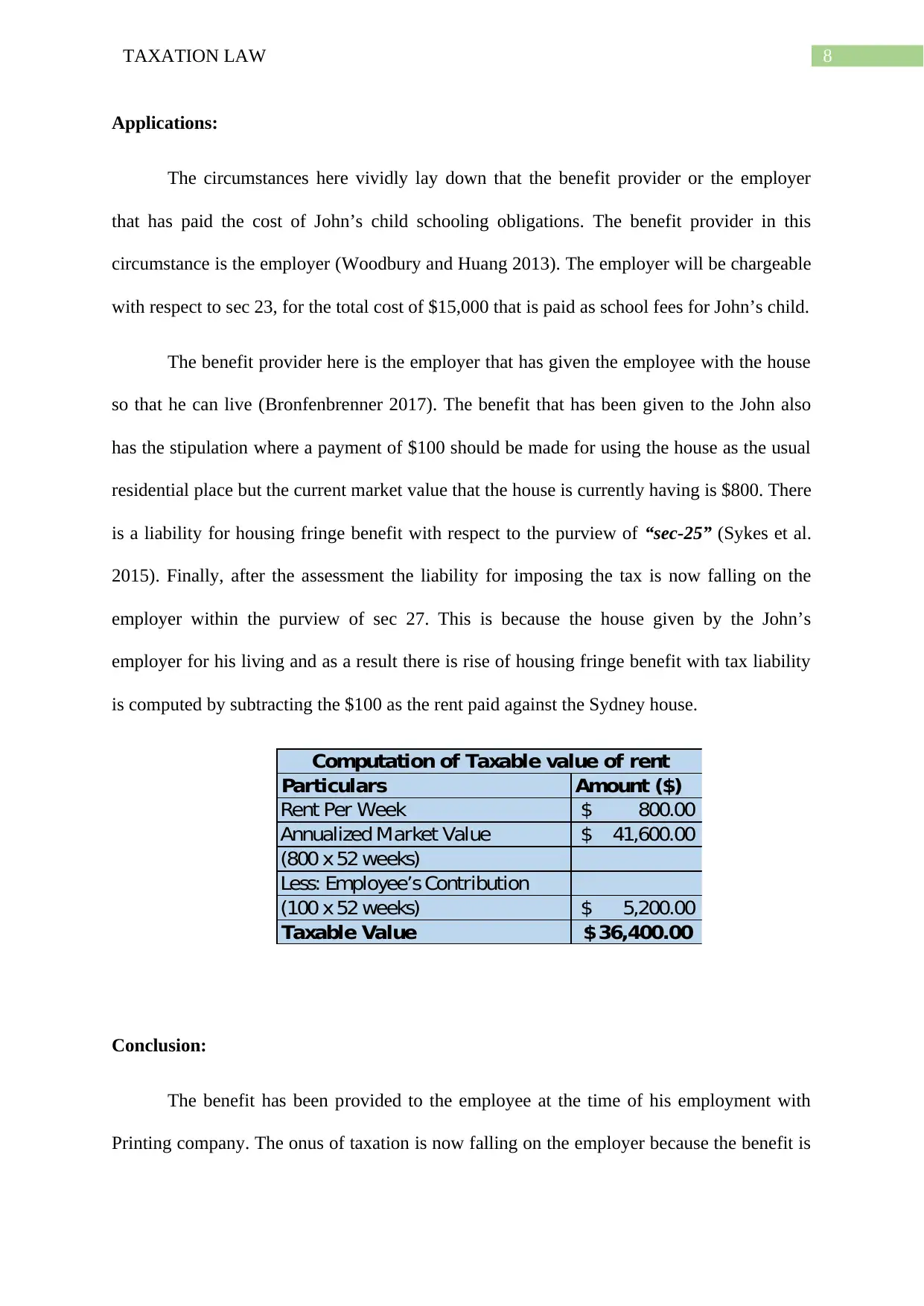
8TAXATION LAW
Applications:
The circumstances here vividly lay down that the benefit provider or the employer
that has paid the cost of John’s child schooling obligations. The benefit provider in this
circumstance is the employer (Woodbury and Huang 2013). The employer will be chargeable
with respect to sec 23, for the total cost of $15,000 that is paid as school fees for John’s child.
The benefit provider here is the employer that has given the employee with the house
so that he can live (Bronfenbrenner 2017). The benefit that has been given to the John also
has the stipulation where a payment of $100 should be made for using the house as the usual
residential place but the current market value that the house is currently having is $800. There
is a liability for housing fringe benefit with respect to the purview of “sec-25” (Sykes et al.
2015). Finally, after the assessment the liability for imposing the tax is now falling on the
employer within the purview of sec 27. This is because the house given by the John’s
employer for his living and as a result there is rise of housing fringe benefit with tax liability
is computed by subtracting the $100 as the rent paid against the Sydney house.
Particulars Amount ($)
Rent Per Week 800.00$
Annualized Market Value 41,600.00$
(800 x 52 weeks)
Less: Employee’s Contribution
(100 x 52 weeks) 5,200.00$
Taxable Value 36,400.00$
Computation of Taxable value of rent
Conclusion:
The benefit has been provided to the employee at the time of his employment with
Printing company. The onus of taxation is now falling on the employer because the benefit is
Applications:
The circumstances here vividly lay down that the benefit provider or the employer
that has paid the cost of John’s child schooling obligations. The benefit provider in this
circumstance is the employer (Woodbury and Huang 2013). The employer will be chargeable
with respect to sec 23, for the total cost of $15,000 that is paid as school fees for John’s child.
The benefit provider here is the employer that has given the employee with the house
so that he can live (Bronfenbrenner 2017). The benefit that has been given to the John also
has the stipulation where a payment of $100 should be made for using the house as the usual
residential place but the current market value that the house is currently having is $800. There
is a liability for housing fringe benefit with respect to the purview of “sec-25” (Sykes et al.
2015). Finally, after the assessment the liability for imposing the tax is now falling on the
employer within the purview of sec 27. This is because the house given by the John’s
employer for his living and as a result there is rise of housing fringe benefit with tax liability
is computed by subtracting the $100 as the rent paid against the Sydney house.
Particulars Amount ($)
Rent Per Week 800.00$
Annualized Market Value 41,600.00$
(800 x 52 weeks)
Less: Employee’s Contribution
(100 x 52 weeks) 5,200.00$
Taxable Value 36,400.00$
Computation of Taxable value of rent
Conclusion:
The benefit has been provided to the employee at the time of his employment with
Printing company. The onus of taxation is now falling on the employer because the benefit is
⊘ This is a preview!⊘
Do you want full access?
Subscribe today to unlock all pages.

Trusted by 1+ million students worldwide
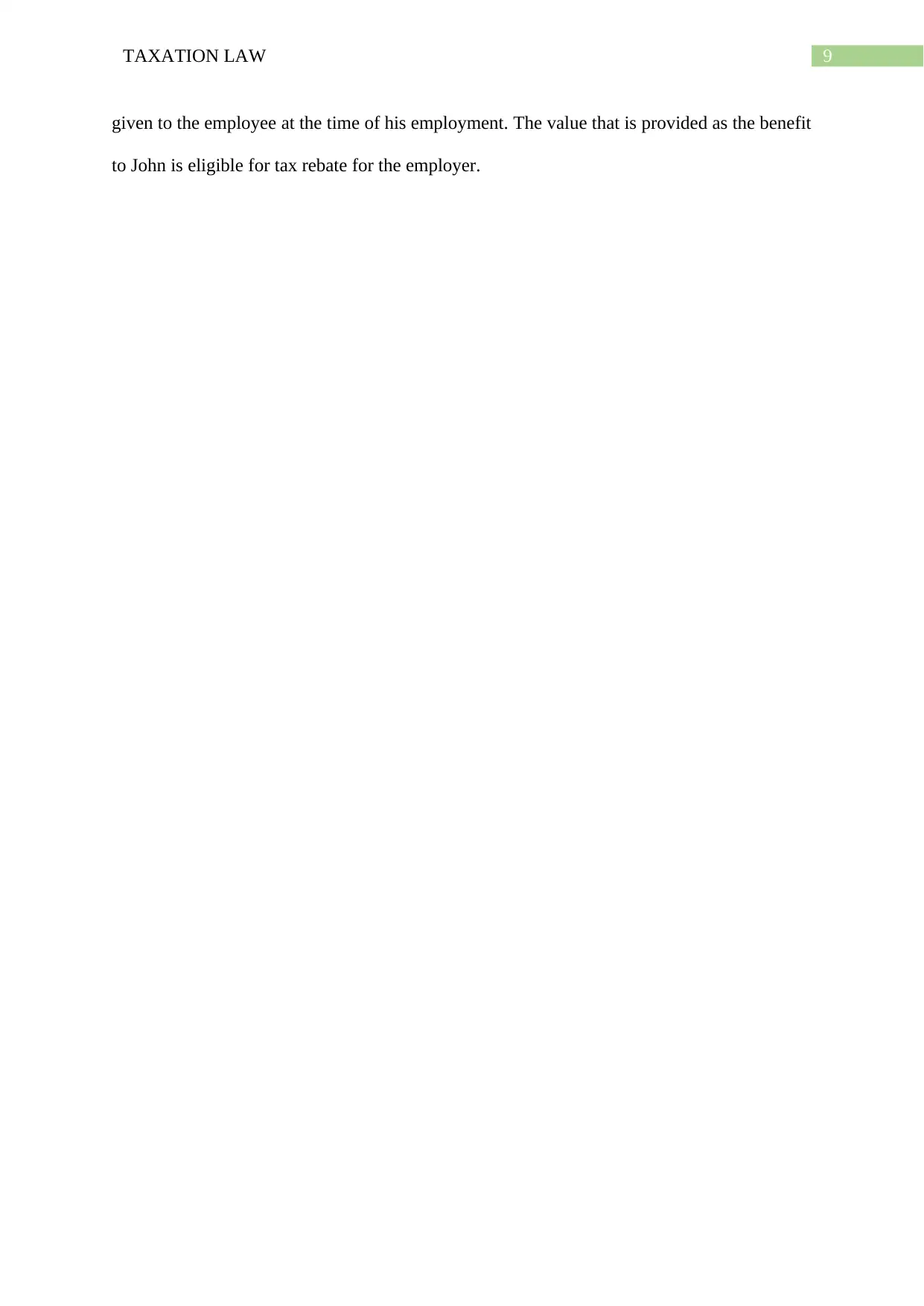
9TAXATION LAW
given to the employee at the time of his employment. The value that is provided as the benefit
to John is eligible for tax rebate for the employer.
given to the employee at the time of his employment. The value that is provided as the benefit
to John is eligible for tax rebate for the employer.
Paraphrase This Document
Need a fresh take? Get an instant paraphrase of this document with our AI Paraphraser
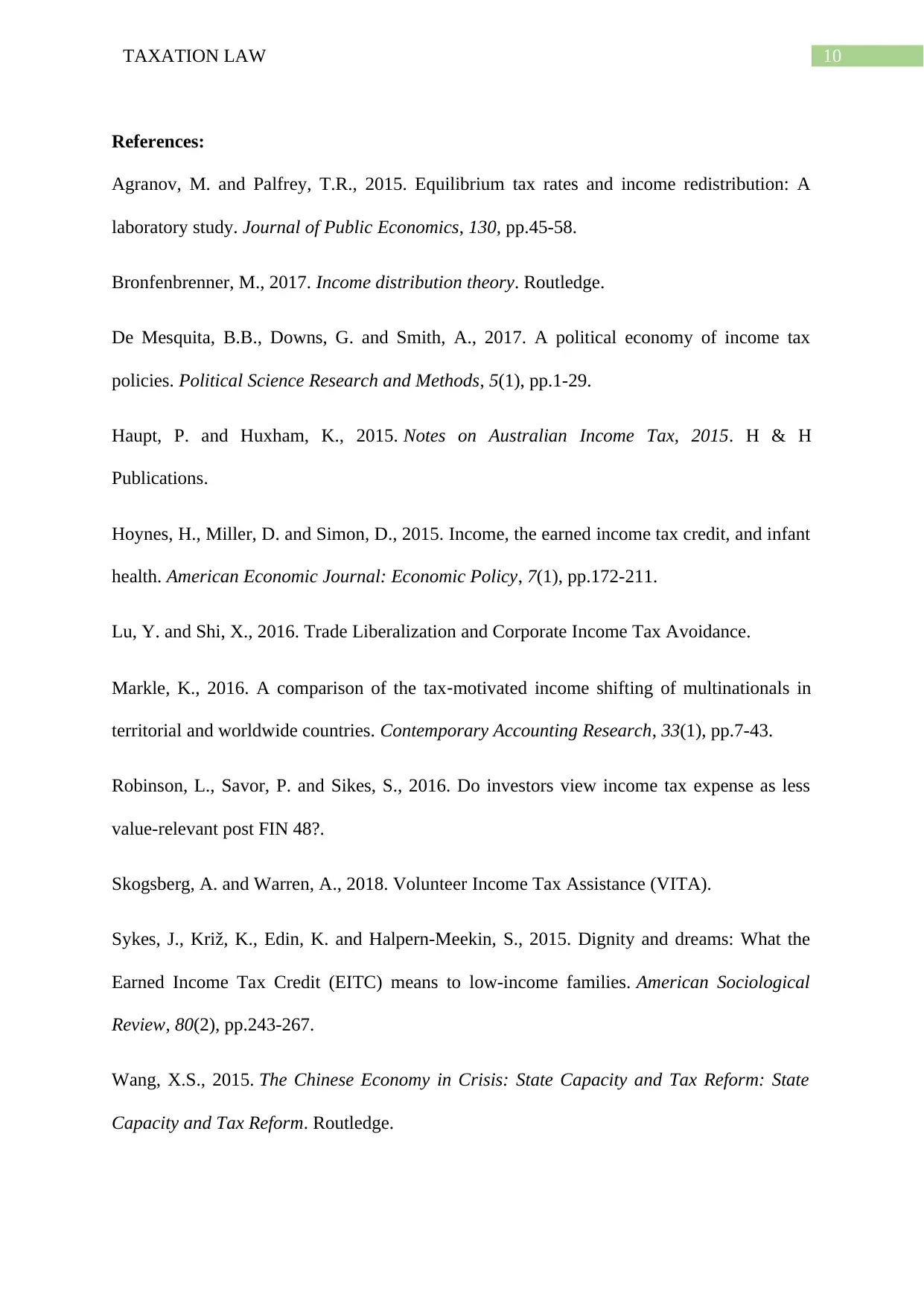
10TAXATION LAW
References:
Agranov, M. and Palfrey, T.R., 2015. Equilibrium tax rates and income redistribution: A
laboratory study. Journal of Public Economics, 130, pp.45-58.
Bronfenbrenner, M., 2017. Income distribution theory. Routledge.
De Mesquita, B.B., Downs, G. and Smith, A., 2017. A political economy of income tax
policies. Political Science Research and Methods, 5(1), pp.1-29.
Haupt, P. and Huxham, K., 2015. Notes on Australian Income Tax, 2015. H & H
Publications.
Hoynes, H., Miller, D. and Simon, D., 2015. Income, the earned income tax credit, and infant
health. American Economic Journal: Economic Policy, 7(1), pp.172-211.
Lu, Y. and Shi, X., 2016. Trade Liberalization and Corporate Income Tax Avoidance.
Markle, K., 2016. A comparison of the tax‐motivated income shifting of multinationals in
territorial and worldwide countries. Contemporary Accounting Research, 33(1), pp.7-43.
Robinson, L., Savor, P. and Sikes, S., 2016. Do investors view income tax expense as less
value-relevant post FIN 48?.
Skogsberg, A. and Warren, A., 2018. Volunteer Income Tax Assistance (VITA).
Sykes, J., Križ, K., Edin, K. and Halpern-Meekin, S., 2015. Dignity and dreams: What the
Earned Income Tax Credit (EITC) means to low-income families. American Sociological
Review, 80(2), pp.243-267.
Wang, X.S., 2015. The Chinese Economy in Crisis: State Capacity and Tax Reform: State
Capacity and Tax Reform. Routledge.
References:
Agranov, M. and Palfrey, T.R., 2015. Equilibrium tax rates and income redistribution: A
laboratory study. Journal of Public Economics, 130, pp.45-58.
Bronfenbrenner, M., 2017. Income distribution theory. Routledge.
De Mesquita, B.B., Downs, G. and Smith, A., 2017. A political economy of income tax
policies. Political Science Research and Methods, 5(1), pp.1-29.
Haupt, P. and Huxham, K., 2015. Notes on Australian Income Tax, 2015. H & H
Publications.
Hoynes, H., Miller, D. and Simon, D., 2015. Income, the earned income tax credit, and infant
health. American Economic Journal: Economic Policy, 7(1), pp.172-211.
Lu, Y. and Shi, X., 2016. Trade Liberalization and Corporate Income Tax Avoidance.
Markle, K., 2016. A comparison of the tax‐motivated income shifting of multinationals in
territorial and worldwide countries. Contemporary Accounting Research, 33(1), pp.7-43.
Robinson, L., Savor, P. and Sikes, S., 2016. Do investors view income tax expense as less
value-relevant post FIN 48?.
Skogsberg, A. and Warren, A., 2018. Volunteer Income Tax Assistance (VITA).
Sykes, J., Križ, K., Edin, K. and Halpern-Meekin, S., 2015. Dignity and dreams: What the
Earned Income Tax Credit (EITC) means to low-income families. American Sociological
Review, 80(2), pp.243-267.
Wang, X.S., 2015. The Chinese Economy in Crisis: State Capacity and Tax Reform: State
Capacity and Tax Reform. Routledge.
1 out of 11
Related Documents
Your All-in-One AI-Powered Toolkit for Academic Success.
+13062052269
info@desklib.com
Available 24*7 on WhatsApp / Email
![[object Object]](/_next/static/media/star-bottom.7253800d.svg)
Unlock your academic potential
Copyright © 2020–2025 A2Z Services. All Rights Reserved. Developed and managed by ZUCOL.





